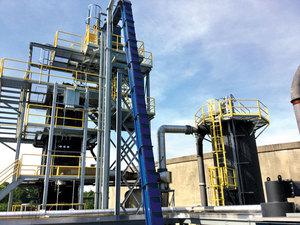Source
Biomass Magazine
Publication Date
September 4, 2019
Markets for biochar, most commonly produced as a gasification or pyrolysis byproduct, are expanding.

Aries Clean Energy gasification plant at Lebanon, TN
By Kathleen Draper, U.S. Director, Ithaka Institute for Carbon Intelligence
When you ask someone if they have heard about biochar, more often than not, you will get a quizzical stare. Fortunately, though, this is beginning to change, as the variety and scale of potential markets for biochar continues to expand.
Biochar is one of the products produced from thermochemical conversion (TC), the baking of organic material using little or no oxygen. TC can, depending on the particular technology used, also generate heat, electricity, bio-oil and wood vinegar. It is increasingly viewed as a cost-effective option for diverting and reducing organic materials currently sent to landfills, which is beginning to take on increased urgency as landfills fill up and organics mandates are adopted by more and more states. Depending on the temperatures used, volume reduction of 75 to 95 percent can be achieved. Imagine reducing a gallon of biomass to a quart (75 percent reduction) or a cup (93.8 percent reduction). Unlike incinerated material, however, the leftover solids do not have to be shipped off as toxic waste. On the contrary, the highly stable carbon material can be used to improve soils, purify water, reduce flooding, remediate brownfields, harvest excess nutrients, lighten up concrete as well as a host of other applications.
The type of biomass being carbonized has a significant impact on the properties of the resulting biochar, as does the temperature, hold time, and technology used to convert the biomass. As an example, research has shown that woody biomass tends to have high carbon, but low nutrient content. Manures and sewage sludge, on the other hand, have lower carbon but higher nutrients. Other variable properties that impact end use and performance include surface area, bulk density, pH, electrical conductivity, nutrients and heavy metals. Increasingly, biochar producers are learning how to produce “fit for purpose” biochars by varying the organic material, processing parameters, and optimizing pre or post processing to adjust the chemical, biological, physical and electrical properties.
A commonly posed question is “What is the difference between charcoal and biochar?” Many use the words interchangeably. Generally speaking, charcoal is used for energy production, whereas biochar is a term used to refer to high-carbon, charred materials that are not subsequently burned but are added to soils or other long-lived products with a goal of preventing the carbon from returning to the atmosphere. Recently, biochar was highlighted as one of only six negative emissions technologies recognized by the Intergovernmental Panel on Climate Change as providing significant opportunity for mitigating climate change. Charcoal is most often made from wood or woody byproducts, while biochar can be made from a much broader range of organic materials including crop residues, food waste, digestate, manures, seaweed, invasive species, and, of course, wood. Another difference is the processing temperature. Yields for charcoal are generally higher than biochar due to lower temperatures. This maximizes heating value but produces carbon with lower surface area and more volatiles.
The most common TC technologies used to produce biochar are pyrolysis (no oxygen) or gasification (limited oxygen). However, a much broader array of technologies, some ancient, some cutting-edge, can be used. Perhaps the oldest technique is a kiln that has been used for millennia to produce charcoal as well as bricks, pottery and more. Hydrothermal carbonization, which works well with high-moisture feedstock is one of the newer carbonization technologies.
One of the better-known combined-heat-and biochar projects is known as the Stockholm Biochar Project. An initial pilot plant used a pyrolysis technology from Germany (Pyreg GmbH) to convert green waste from the city into heat that was utilized in the district heating system, and biochar that was used for urban tree planting and stormwater management. Based on the success of the pilot, the system is being replicated in other cities in Sweden, Europe and beyond.
Electricity production via gasification with a biochar byproduct can be found at a growing number of installations. Since 2016, Aries Clean Energy has been running a plant in Tennessee that provides electricity to a nearby wastewater treatment facility. This power is generated using wood waste that was previously sent to landfills. The plant can annually produce 1,000 tons of consistent, high-carbon biochar that meets the International Biochar Initiative standards for use in soils. Editor’s note: Aries GREEN® Biochar holds both International Biochar Institute and USDA certifications. For more info: https://ariescleanenergy.com/biochar/biochar-sales/
Syncraft, an Austrian company making gasification equipment, has units that provide enough electricity for a small village, and the ability to vary biochar output according to market conditions. The biochar produced in their European locations is of sufficiently high quality that it is sold as an animal feed additive (something which is not currently legal in the U.S., though many in the industry are working to change this). Oregon Biochar Solutions and Pacific Biochar both promote products which result from biomass to energy production.
One of the original markets for biochar was agriculture. This still remains a large market, though the economics can be challenging in certain farming scenarios. The impact biochar has on soils and different crops is inconsistent, as it tends to have a greater yield-boosting impact on poorer soils and in regions where it is difficult to build a deep organic soil layer. Promising ag markets for biochar must necessarily focus where the economic impact is higher than the cost of biochar. In drought-challenged areas where farmers pay for water, biochar can help improve water management. In certain types of perennial agriculture, biochar use can get trees into fruit or nut production earlier. As certain types of biochar can reduce plant uptake of metals, biochar use could mean the difference between being able to market your products or not when farmers find they have toxic soils.
Much of the more recent focus for biochar has been nonagricultural markets where activated carbon (AC) has traditionally been used such as filtration, remediation, animal feed and more. Biochar can often compete effectively with AC from a cost perspective. It is now being looked at as a replacement for carbon black which is used as a filler and dye in various types of plastics and in tires.
Currently, perhaps one of the biggest markets by volume in the U.S. is composting. While some may perceive biochar to be competitive with composting, the two are actually synergistic. Adding 10 to 20 percent biochar in the early stages of composting can reduce processing time, increase heating temperatures which kills of more pathogens or weed seeds, retain more nutrients and boost long-term carbon content, all of which translates into high-value compost.
Another high-volume, though low-value market that is beginning to emerge is in livestock farming. Biochar can be used as bedding or as part of a manure management system to reduce odors, retain nutrients and improve the carbon content in the manure.
Stormwater management is likely to be a large market for biochar as cities and residents look for ways to increase infiltration of water while reducing toxins. Research at the University of Delaware concluded that biochar could effectively compete with many of the current best management practices in stormwater management.
These and other evolving markets take time to develop at a local and regional level. One challenge for those making biochar as a byproduct of biomass energy production is that these are new products and new markets that are not well understood. To alleviate this challenge, some biochar technology vendors are offering to buy all biochar produced, as they are interested in waste mitigation as well as biochar marketing.
 Author: Kathleen Draper
Author: Kathleen Draper
U.S. Director, Ithaka Institute for Carbon Intelligence
Kdraper2@rochester.rr.com
www.biochar-journal.org


